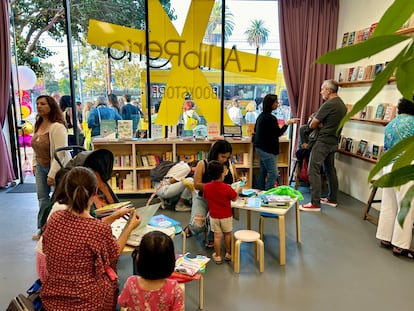When your language faces extinction: A photographic exhibition highlights over 120 endangered languages in the US
The photojournalist and poet B.A. Van Sise explores the fragility of endangered languages in his book and Los Angeles museum exhibition, showcasing 50portraits that tell the stories of languages on the brink of disappearing forever
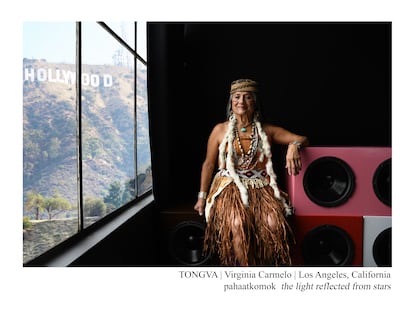

In the United States, there is no official language, but there is clearly unofficial one: English. Spoken by the majority of the population, it is used by 241 million people according to 2019 census data, and 95% understand the language. However, Spanish, spoken by nearly 63 million people according to the Cervantes Institute’s latest yearbook, is the second most common language. Other languages like Chinese (four million speakers as of 2019), Tagalog (1.8 million), Vietnamese (1.6 million), and Arabic (1.3 million) also have significant presences, uniting their communities and fostering vibrant social, cultural, and economic dynamics. But what happens when your language is spoken by just 200 people, a dozen, or perhaps only by you? In such a vast country, these endangered languages also exist — more than you would expect.
Photographer, reporter, poet, and researcher B.A. Van Sise has traversed much of the U.S. to document over 100 endangered languages. An American citizen of Italian heritage (with family roots in Belgium and France), Van Sise has Jewish ancestors who were expelled from the Spanish city of Seville — he even speaks Ladino. For him, languages form the core of identity, and a few years ago, he set out to explore their distribution across the United States. The result of that three-year project is a collection of photographs featured in both a book and an exhibition. On the National Language: The Poetry of America’s Endangered Tongues is published by Schiffer Publishing and is on display at the Skirball Cultural Center in Los Angeles until next March.
Seated on a sunny terrace at Skirball, amidst the cool Los Angeles winter, Van Sise explains how his passion for capturing people in their environments fueled this project. Initially, he began photographing experts with the deepest knowledge of these endangered languages. But when he spoke to these groups to ask for portraits, he found himself invariably directed to older men. But that wasn’t what he was looking for: he wanted to know how these languages lived and breathed. So he began to photograph teachers sharing the language, housewives speaking it at home, and schoolchildren learning it.
“That’s when I realized two things,” he says. “First, it’s a project about the future, not about the past. And B, I realized that I would do much better to entirely bypass the political organizations that are involved in all of this, which is a controversial decision.” He wanted to focus on people, on survival, on how much is needed to protect these languages.
The exhibition features 50 portraits of individuals who are fighting to preserve their languages in the United States — which is no easy task, but one he is committed to bringing to the forefront. It is not just about language; it’s not just about Navajo, which still boasts 150,000 speakers, Tongva, O’odham, Koyukon, Kouri-vini, and Cahuilla, which has only five speakers left in California’s deserts. It is about entire cultures, words that do not exist in other languages, systems of thought. Van Sise collaborated with over 70 communities, many Indigenous and dispersed across the U.S., to spotlight what might otherwise remain unseen. In his work, he emphasizes: if it isn’t seen, it doesn’t exist.
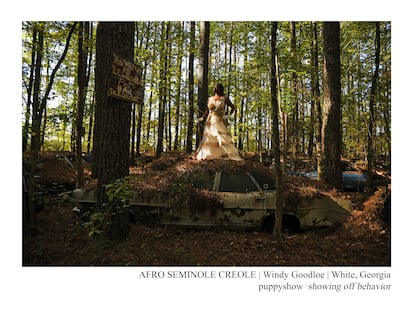


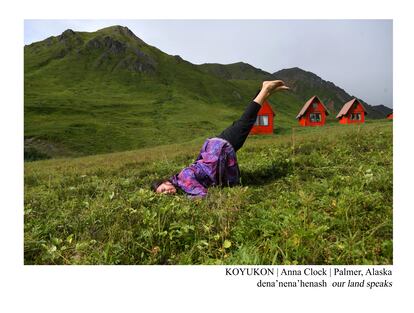

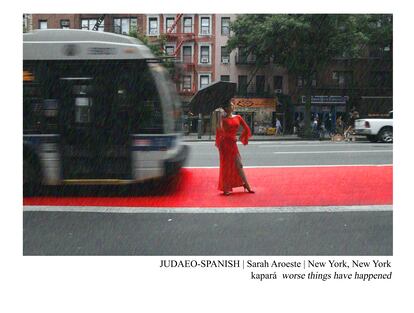
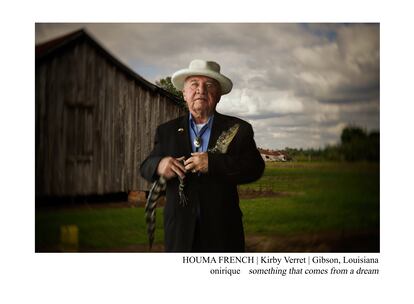
But why do languages die? “It’s caused by power. It’s caused by war. It’s caused by money. It’s caused by somebody who speaks X and Y and Z language, who happens to be sitting on top of a reserve of oil or a lot of land,” explains Van Sise. He also believes the unique idiosyncrasies of the United States contribute to the fragility of these languages. “If you have a big nation state that drives a language, it’s different. If you’ve got 25 people doing their best in an angry environment, the language change quickly to adapt to this situation.”
The majority of endangered languages in the U.S. — between 80% and 90% — belong to Indigenous peoples. But not all. The list extends beyond these groups, including languages from the Black diaspora, Haitan Creole, and Judaic-based tongues. Van Sise estimates that around 120 languages in the country are at high risk of extinction: “That’s a lot,” he says. Reflecting on history, he notes that when Spanish and English colonizers arrived, they encountered “several thousand” languages across the continent.
According to Van Sise, Americans have a deep fascination with how and what is spoken because of an underlying desire to reconnect with their origins.
“They’re anxious to recover the umbilical cord to their origins,” he says. “Americans, I think, crave the ability to build that back, and you build that back through conversation, through language. Americans cling to origin in a way that I think a lot of folks don’t. That’s why genealogy is such a big pastime in America, and elsewhere it isn’t. Europeans don’t care about their genealogy.”
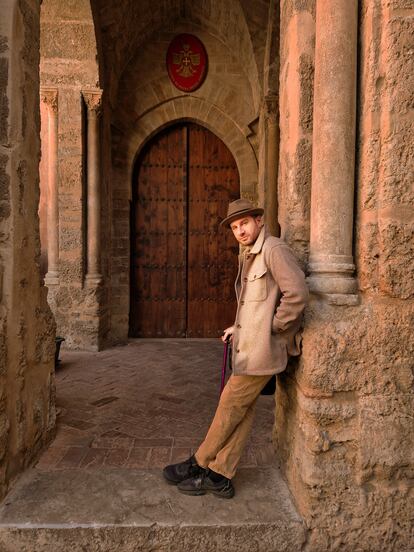
For Van Sise, the incoming Donald Trump administration, significantly more conservative than Joe Biden’s, poses a potential threat to the expansion and survival of endangered languages. “If I was an Indigenous person working on language revitalization, I would be beside myself with grief right now for what’s happening in an American government,” he says. “We’re going to have this really big turn away from this multiethnic understanding of America. I do not feel that the incoming government is inclined to create a great deal of space for American diversity. I think they’ll appoint plenty of people to move in the opposite direction.”
“You’re going to see people drilling on reservations, natural reserves and places that are sacred,” he continues. “You’re going to see the money for language and cultural vitalization dry up. You’re going to see really big challenges going forward. I don’t know if I think that the change is going to be permanent,” he adds, an optimist by nature.
All the languages Van Sise documented are from within the United States; he hasn’t ventured across its borders, though he would have liked to expand his research to Canada and Mexico. He admits to cheating a little by including Nahuatl, the most important language of the Aztecs and the most widely spoken Indigenous language in the Americas, with 1.5 million speakers. Most Nahuatl speakers are in Mexico, but it’s true it’s also spoken by some residents in the U.S., especially in California.
He regrets not being able to explore the languages of the Pacific. He had plans to document seven endangered tongues in Hawaii but ran out of time before his book’s deadline. Van Sise does not know if he will make the trip, because he is already preparing a new project about U.S. citizens who have spent many years in prison, a work he describes as more focused “on the human than the criminal element.” For now, Hawaii will have to wait.
Sign up for our weekly newsletter to get more English-language news coverage from EL PAÍS USA Edition
Tu suscripción se está usando en otro dispositivo
¿Quieres añadir otro usuario a tu suscripción?
Si continúas leyendo en este dispositivo, no se podrá leer en el otro.
FlechaTu suscripción se está usando en otro dispositivo y solo puedes acceder a EL PAÍS desde un dispositivo a la vez.
Si quieres compartir tu cuenta, cambia tu suscripción a la modalidad Premium, así podrás añadir otro usuario. Cada uno accederá con su propia cuenta de email, lo que os permitirá personalizar vuestra experiencia en EL PAÍS.
¿Tienes una suscripción de empresa? Accede aquí para contratar más cuentas.
En el caso de no saber quién está usando tu cuenta, te recomendamos cambiar tu contraseña aquí.
Si decides continuar compartiendo tu cuenta, este mensaje se mostrará en tu dispositivo y en el de la otra persona que está usando tu cuenta de forma indefinida, afectando a tu experiencia de lectura. Puedes consultar aquí los términos y condiciones de la suscripción digital.
More information
Archived In
Últimas noticias
The metaverse, four years later: Is it finished or just at a standstill?
$3,000 and a plane ticket: The United States increases incentives for migrants to self-deport before the end of the year
Charles Dubouloz, mountaineering star, retires at 36 with a farewell tour inspired by Walter Bonatti
From the White House to diplomatic gifts: Lego wins over adult fans, brick by brick
Most viewed
- The low-cost creative revolution: How technology is making art accessible to everyone
- Christian Louboutin: ‘Young people don’t want to be like their parents. And if their parents wear sneakers, they’re going to look for something else’
- All the effects of gentrification in one corner of Mexico’s Colonia Roma
- Christmas loses its festive spirit: ICE fears cast shadow over religious celebrations
- Liset Menéndez de la Prida, neuroscientist: ‘It’s not normal to constantly seek pleasure; it’s important to be bored, to be calm’
